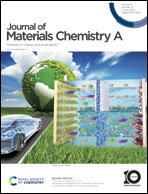Efficient immobilization and bidirectional catalysis of polysulfide conversion by FeCoP quantum dots for lithium–sulfur batteries†
Abstract
Using polysulfide electrocatalysts has become an effective strategy to improve the durability of lithium–sulfur batteries (LSBs) by regulating the precipitation and dissolution of lithium sulfide in the electrolyte. In this study, an FeCoP quantum dot (FeCoP-QD)-decorated nitrogen-doped carbon nanosheet (FeCoP-NCS) composite was prepared as a sulfur host for LSBs. In comparison with the other sulfur hosts reported in the literature, the optimal FeCoP-NCS sulfur host exhibited a fantastic bidirectional catalytic effect by greatly accelerating sulfur reduction during discharge and Li2S oxidation during charging. The NCS substrate matrix with large specific surface area and high porosity provided the necessary channels for electron and ion transport. The assembled LSBs with the S@FeCoP-NCS cathode displayed a high capacity of 406 mA h g−1 at 5C current density. Meanwhile, an excellent cycling performance with a capacity decay rate of 0.07% per cycle was observed for 500 cycles at 1C. This work demonstrated the potential of the FeCoP-NCS composite to be employed as an LSB electrode material with high-rate performance and long-term cycle stability.

- This article is part of the themed collection: 2023 Journal of Materials Chemistry A HOT Papers


 Please wait while we load your content...
Please wait while we load your content...